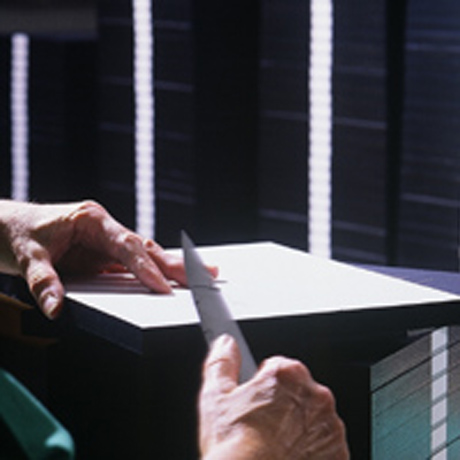Designed for use in all situations, the block (4-sided glue pad) allows you to use all types of wet techniques without pre-treating the paper: It is the perfect companion for nomadic artists.
- Home
- Expert advice
- Watercolor blocks
1. Composition
- Rigid Cardboard (or Rubber) Backing: You can place your pad directly onto your easel, a table… and even your knees!
- A Supple Cover: Fixed to the rubber backing, it folds back easily under the block.
- 10-50 Sheets of Paper by Weight: A coating of glue, applied directly to a sheet of paper, stabilizes and assures its tension.
2. A Medium for Each Paper
- The block is designed for all wet techniques: oil, acrylic, and especially watercolor, which requires great quantities of water.
- The principal types of paper used in these media are available in pads: smooth, grained, in various weights and classic fine arts formats.

3. How To Use Them
Gluing the sheets of paper ensures a perfect session:
- There’s no risk of curling in the presence of water! It is therefore unnecessary to pre-treat the paper: the block is ready-to-use.
- Once the work is finished, and after the drying is complete, delicately separate the used sheet of paper from the rest of the block with the help of a fine blade (razor, scalpel…). A fissure in an angle or at the center of one of the sides permits blade insertion.
- The next sheet is ready to use!
4. Advantages
Adaptable, the block is spontaneity’s best friend. Ready to use in any situation, it allows you to save precious time and to work as easily outdoors as in the studio. Having regularized the tension of the sheets of paper, the risk of distortion is entirely eliminated.
Trick of the Trade: A Palette … Made of Paper
Along the same lines, “palette” pads offer a succession of glued sheets of paper. They take the shape of a real painter’s palette, with a central hole to make manipulation easy. Mix your colors directly onto the top sheet, exactly as you would do with your usual palette. The difference? Once your work is finished, you need only detach and throw away the used sheet of paper. Fastidious cleaning sessions are over!
Recommended product:
Aquarelle Canson
See also :
Watercolour
Selecting your watercolor paper
Explore more tutorials on this technique
Watercolour
How to enrich a travel sketchbook
Watercolour
Painting a duck in flight with watercolours
Watercolour
Watercolour pencils: how do I use them properly?
Watercolour
How do I use watercolour ink?
Watercolour
How to paint a seaside landscape in watercolour?
Watercolour
Making Watercolor Paint, Oil Paint, and Gouache
Watercolour
The travel album
Watercolour
Paint and Draw Outdoors
Watercolour
Drawing: Secrets of perspective
Watercolour
Color Basics
Watercolour
Watercolor: Making colors lighter
Watercolour
Watercolor: Creating bleeding
Watercolour
Watercolor: Dry brush painting
Watercolour
Watercolor: Splattering
Watercolour
Watercolor: Trying out different textures
Watercolour
Watercolor: Leaving white spaces
Watercolour
Watercolor: Doing a graduated wash
Watercolour
Watercolor: Salvaging your mistakes
Watercolour
Using watercolor pencils
Watercolour
Watercolor: Doing a flat wash
Watercolour
Watercolor: Seascape under stormy sky
Watercolour
Manufacturing secrets: Watercolor paper
Watercolour
Watercolor: Painting trees
Watercolour
Preparing your watercolor materials
Watercolour
Selecting your watercolor paper
Watercolour
Watercolor: Choosing your colors
Watercolour
Choosing your watercolor paintbrushes
Watercolour
Watercolor: colors and water dilution
Watercolour
Basic concepts for painting with watercolors
Watercolour
Learn watercolors in 6 steps
